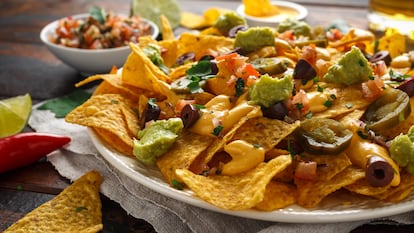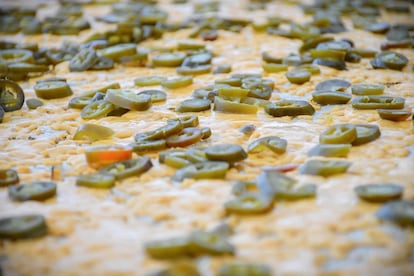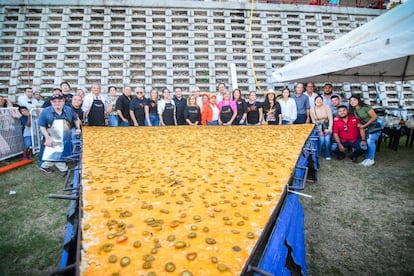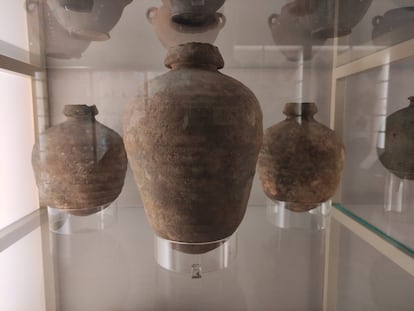A cook named Ignacio and three ingredients: Nachos, the most American of all Mexican food, or was it the other way around?
Tortilla chips with cheese and jalapeños are one of the most important Tex-Mex dishes in global gastronomy and the most beloved in the United States. Invented 80 years ago, today their popularity is such that they even have their own festival in the State of Coahuila


Being as simple as they are delicious and ubiquitous, it seems like nachos have always been around. A handful of freshly fried tortilla chips, smothered in melted cheese and topped with fresh, crispy, spicy jalapeños. Together, with a touch of the oven, it’s the perfect and constant snack on the menu of almost any restaurant, whether in the United States, Mexico (not without a few sidelong glances) and, by extension, halfway around the world. However, the history of nachos is short and surprisingly traceable. They were invented 80 years ago in a small border town between the United States and Mexico and yes, the old joke about eating “Ignacios” (Nacho is a nickname for Ignacio) is based in truth: their creator was a Mexican cook named Ignacio Anaya.
Their success has been undeniable. While many would first perhaps think of tacos, guacamole or even burritos, a recent YouGov survey found that, in the first quarter of 2024, nachos were the most popular Mexican dish in the U.S. CNN considers them the sixth most-popular dish in the country, behind only Thanksgiving turkey, the cheeseburger, a Reuben sandwich, hot dogs, and the Philly-style cheese steak sandwich. Nearly 240 million Americans eat tortilla chips every year, and when the Super Bowl comes around, consumption soars by 35%. Its name is so popular that the main ingredient, the tortilla chip, called totopo in Mexico, is known simply as nacho in countries like Spain or Colombia. In less than a century, its popularity has crossed borders and it even has a festival named after it that has been held for the past 30 years. But every success has its share of controversy: are they a Mexican or an American dish? And that question can be followed by another: does it really matter?
Edgar Salgado is the director of the Escuela de Gastronomía Mexicana, one of the most important cooking schools in the country, founded 17 years ago and privately owned. He recognizes that in Mexico, nachos “are present as a dish, but not in a popular way in the streets; it is more in restaurants, in North American food chains.” For him, they represent the purest form of Tex-Mex. “In this case the legend is very precise, but it is not as clear how they crossed the border and consolidated themselves as Tex-Mex food,” reflects Salgado.

In the opinion of the gastronomic historian, until a few years ago Tex-Mex was considered internationally as being Mexican. “People thought of Mexican cuisine and thought of nachos, tortillas, as internationalized by chains such as Taco Bell,” he acknowledges. “But it is indeed fusion cuisine, because there are very marked elements in it as part of traditional Mexican cuisine.” For years, as the expert explains, the U.S. has been a great exporter of what has been considered Mexican cuisine, and as such it has imposed enormous influence on it. “Now more and more effort is being made to showcase the real food, of which there is a vast amount. As a megadiverse country, we have a lot of resources,” Salgado says.
Nachos were created in Piedras Negras, a town in the state of Coahuila, which borders Eagle Pass, Texas: the Tex and the Mex. In addition, they were invented by a Mexican cook for some Texan women who were visiting the town. Adriana Reyna, director of Municipal Tourism in Piedras Negras, offers the official version. “They were created in 1943 in a well-known restaurant in town [Club Victoria, which closed in 1961]. Ignacio Anaya was the maître d’ and the restaurant was closing up when some foreign women showed up, the wives of military men from the border city.” The guests were hungry and Anaya, with the stoves already turned off, had no choice but to improvise. “He took some tortillas, made them into triangles and fried them, added Wisconsin cheese, put them in the oven and added jalapeños,” says Reyna, who also explains how they came to get their name: “They asked him what the dish was called, but mishearing the question, he replied: ‘My name is Nacho.’” And the dish’s ad hoc baptism was left for posterity.
People remember the taste because it unites several elements that represent the people: the crunchiness of the totopo, the spiciness of the jalapeño, although it is mild, the cheese... It is a complete meal”Edgar Salgado, director of the Escuela de Gastronomía Mexicana
Salgado acknowledges that the story has its dose of local romanticism, but also that the recipe had everything to gain. First, because the dish stayed on the menu and continued to be served “without anyone knowing that it was a circumstantial dish. Then there was the law of demand as word spread, first on a small scale, and then on a larger scale,” he explains. The location of the restaurant, on the border between the two countries and on a major trucking route, also helped the dish’s expansion. The recipe would later reach many more U.S. states. The combination of ingredients was also a success. “People remember the taste because it unites several elements that represent the people: the crunchiness of the totopo, the spiciness of the jalapeño, although it is mild, the cheese... It is a complete meal,” says Salgado, who believes that “with the simplification of eating habits it is fast, easy, economical cuisine” that is also “malleable,” because it can be personalized and developed to suit personal tastes. He also stresses “the issue of sharing: not only what you eat, but with whom you eat it.” And if anything is easy to share, it’s nachos. There was another key element in their quick spread: “Ignacio Anaya never registered anything,” says Adriana Reyna. “He didn’t get any financial benefit.”

That expansion was dazzling. The oldest restaurant in the city of Los Angeles — the epicenter of Mexican-American culture par excellence — El Cholo has been running for 101 years and has been serving the original style nachos for 65. They are a hit. They also have Sonora Style Nachos, with sour cream, guacamole and beans, but customers ask for one as much as the other, and they ask for them a lot. Between pictures of Jack Nicholson and menus from the days when tap beer cost 15 cents, the plates come out blazing with crispy tortilla chips, a layer of cheese and a good helping of jalapeños. Óscar Cruz, who has worked at El Cholo for 35 years and is now its manager, says that they first appeared on the menu in 1959. In L.A. lore a waitress named Carmen Rocha invented the dish; everything fits after the Mexican-Texan origin of the original nachos came to light 15 years ago. “Of course, she was from Texas,” says Rocha.
The head of Piedras Negras tourism recognizes that the success was resounding from the beginning, among other reasons because they hit the nail on the head with a mix of ingredients that underpins the cuisine of the region. “Our gastronomy is very Tex-Mex: what the restaurants sell most are golden tacos, hamburgers, nachos... This is not southern Mexico, with tlacoyos and quesadillas,” she laughs during a telephone conversation with EL PAÍS. For Piedras Negras, the dish is key, because it puts the town more and more on the map. Anaya died in the mid-1980s and has no descendants in the city, but his relatives continue to visit, especially during the Festival del Nacho or, as it is popularly called, simply “El Nacho.”
The festival, which in October will hold its 30th edition, offers precisely what its name promises: the fried and well-seasoned totopo is king. A Nacho Board of Directors with 15 members maintains the festival as an entity independent of whatever political party governs and seeks to boost the relevance and knowledge of the dish and the event. “People eat nachos and nobody knows what they are or where they come from, and they said to themselves: ‘We have to do something,’” Reyna recalls. “They created a Miss Tourism contest, then the best exotic nacho competition, and also the best traditional nacho: corn tortilla chips fried in oil with Wisconsin cheese and jalapeño, nothing else.”
We don’t have a beach or anything like that; we made this ourselves”Adriana Reyna, director of Municipal Tourism in Piedras Negras, Coahuila
Then came the Guinness record. And they beat it, year after year. In 2023 an immense totopo five and a half meters long on each side was created. “It is cooked on a special comal, then it is cut and given to everyone present,” explains Reyna, who is proud that the city receives more than 4,000 visitors from northern Mexico and Texas, but also “from Oklahoma, Arkansas, nearby universities...”
As the head of tourism explains, Piedras Negras has been the second-safest city in Mexico and the safest on the border for eight years; it needs and promotes a different kind of tourism than that with which many people associate Mexico. “And we see it reflected. We have medical tourism with more than 300 dentists, cosmetic doctors and pediatricians, with 70% of the clientele from the U.S., and also business tourism, with 40% hotel occupancy year-round. We don’t have a beach or anything like that; we made this ourselves.”

And they do not look down on Nacho or his Tex-Mex origins, far from it. Nor does Edgar Salgado believe that the average Mexican, in general, rejects the humble and mixed origin of the dish. “I don’t think anyone thinks about it, they accept it without any misgivings.” The academic world is more complex: liberals like him accept it and treat it “as a historical entity,” while anthropologists “are more purist; their definition of cuisine is that of an inherited tradition.” But when anybody, on either side of the border, sits down in front of crispy, spicy, cheese-laden tortilla chips, they only use their mouths to eat.
Sign up for our weekly newsletter to get more English-language news coverage from EL PAÍS USA Edition
Tu suscripción se está usando en otro dispositivo
¿Quieres añadir otro usuario a tu suscripción?
Si continúas leyendo en este dispositivo, no se podrá leer en el otro.
FlechaTu suscripción se está usando en otro dispositivo y solo puedes acceder a EL PAÍS desde un dispositivo a la vez.
Si quieres compartir tu cuenta, cambia tu suscripción a la modalidad Premium, así podrás añadir otro usuario. Cada uno accederá con su propia cuenta de email, lo que os permitirá personalizar vuestra experiencia en EL PAÍS.
¿Tienes una suscripción de empresa? Accede aquí para contratar más cuentas.
En el caso de no saber quién está usando tu cuenta, te recomendamos cambiar tu contraseña aquí.
Si decides continuar compartiendo tu cuenta, este mensaje se mostrará en tu dispositivo y en el de la otra persona que está usando tu cuenta de forma indefinida, afectando a tu experiencia de lectura. Puedes consultar aquí los términos y condiciones de la suscripción digital.
More information
Archived In
Últimas noticias
Welcome to the post-religion era: The idea of Christianity as the absolute truth has become obsolete
‘I thought you would like it’: The risky sexual practice popularized by TV shows and TikTok
The digitalization of tourism: ‘They promise experiences and gave us the worst possible one’
Mexican peso defies uncertainty with forecasts of a new period of stability in 2026
Most viewed
- Sinaloa Cartel war is taking its toll on Los Chapitos
- Reinhard Genzel, Nobel laureate in physics: ‘One-minute videos will never give you the truth’
- Oona Chaplin: ‘I told James Cameron that I was living in a treehouse and starting a permaculture project with a friend’
- Why the price of coffee has skyrocketed: from Brazilian plantations to specialty coffee houses
- Silver prices are going crazy: This is what’s fueling the rally










































